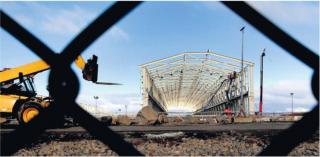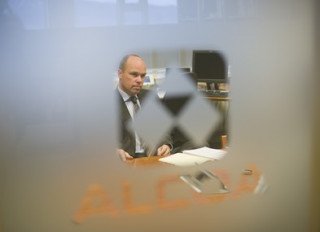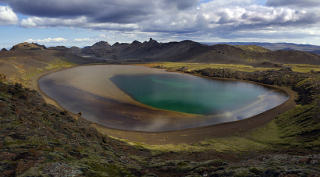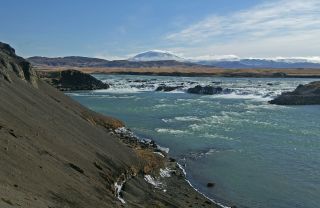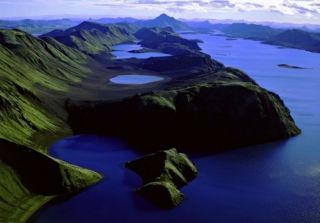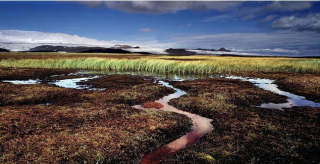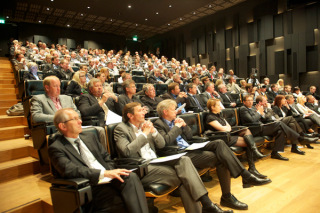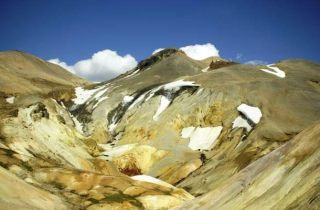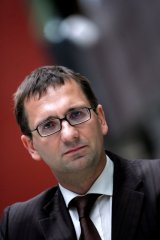'Landsvirkjun'
Tag Archive
Nov 16 2011
Alterra Power/Magma Energy, Century Aluminum, Energy Master Plan, Geothermal Energy, H.S. Orka, Helguvík, Landsvirkjun, Saving Iceland, Sigmundur Einarsson, Þjórsá
Plans to operate a 250-360 thousand ton aluminium smelter in Helguvík, which has in fact been under construction since 2008, seem ever more likely to be nothing but an inoperable myth of the past, according to environmentalists as well as high ranking officials within the energy sector. Aluminium producer Norðurál (alias Century Aluminum, which already operates one smelter in Iceland), has not only been unable to guarantee the necessary minimum 435 MW of energy but is also stuck in an arbitration conflict with its planned energy supplier HS Orka (owned by Alterra Power, former Magma Energy), concerning energy price. Additionally, environmentalists’ warnings – that the geothermal energy planned to run the smelter can simply not be found – have gained strength and lead to the inevitable question if the damming of river Þjórsá has been planned for Helguvík.
During a recent meeting of chairmen from all the member unions of the Icelandic Confederation of Labour (ASÍ), Hörður Arnarson, the director of the national energy company, Landsvirkjun, said that due to the current situation on international markets it would be enormously difficult for Norðurál to finance the 250 billion ISK smelter project. According to Vilhjálmur Birgisson, who attended the meeting, chairman of the Labor Union of Akranes (near to Grundartangi, where Century’s currently operating smelter is located), Hörður spoke of the Helguvík project’s likelihood as very negligible. Another representative at the meeting, Kristján Gunnarsson, chairman of the Labour and Fishermen Union of Keflavík, stated that when asked about the possibility of Landsvirkjun selling energy to Norðurál, Hörður answered saying that no energy is really available for the project.
While it certainly is true that Landsvirkjun has, especially in the nearest past, had problems with financing, due to the international financial crisis as well as the Icelandic economy’s instability, the latter point – that no energy is actually available for Helguvík – is of more importance here. Environmentalists have, from the beginning of the Helguvík project, stated that the plans to harness energy for the smelter in geothermal areas on the Reykjanes peninsula, are not sufficient, for two reasons. Firstly, as the alleged size of the energy extraction is not sustainable and is more than likely to drain these unique natural areas for good. Secondly, because even if fully exploited, the geothermal areas would not produce enough energy for the smelter. Another energy source will be essential in order for the smelter to operate and even though Reykjavík Energy (OR) has promised Century some energy from a planned enlargement of their power plant in Hellisheiði, the aluminium producer still faces a serious lack of electricity for Helguvík. Read More
Nov 05 2011
2 Comments
ALCOA, Century Aluminum, Landsvirkjun, Media bias, Reykjavik Energy, Rio Tinto Alcan, Samál (the Icelandic Association of Aluminium Producers)
By Snorri Páll Jónsson Úlfhildarson, originally published in The Reykjavík Grapevine.
Those who are yet to give up on Icelandic media cannot have avoided noticing one Kristján Már Unnarsson, a news director and journalist at TV station Stöð 2. Kristján, who in 2007 received the Icelandic Press Awards for his coverage of “everyday countryside life”, is a peculiar fan of manful and mighty constructions and loves to tell good news to and about all the “good heavy industry guys” that Iceland has to offer.
To be more precise, Kristján has, for at least a decade (and I say “at least” just because my memory and research doesn’t take me further back), gone on a rampage each and every time he gets the chance to tell his audience about the newest of news in Iceland’s heavy industry and energy affairs. He talks about gold-mills when referring to dams built to power aluminium production; and when preparing an evening news item on, say, plans regarding energy and aluminium production, he usually doesn’t see a reason for talking to more than one person – a person who, almost without exception, is in favour of whatever project is being discussed.
After witnessing Kristján’s latest contribution to the ongoing development of heavy industry and large-scale energy production, i.e. his coverage of Alcoa’s recently announced decision not to continue with its plan of building a new aluminium smelter in Húsavík, wherein he managed to blame just anything but Alcoa itself for the company’s decisions, I couldn’t resist asking (and, really, not for the first time): What can really explain this way too obvious one-sidedness, manifest not only in this one journalist’s work but seemingly the majority of news coverage concerning heavy industry? Read More
Oct 18 2011
7 Comments
ALCOA, Bakki, Economics, Geothermal Energy, Greenland, Landsvirkjun
After a six years process Alcoa in Iceland has withdrawn its plans to build a 250 thousand ton aluminium smelter in Bakki, near Húsavík in the North of Iceland. It is now clear, according to the company, that the energy needed to run the proposed smelter will not be provided and, even if it could be provided, the company finds the price too high. Tómas Már Sigurðsson, the director of Alcoa in Iceland, announced this yesterday on a meeting in Húsavík, marking a milestone in the struggle against the aluminium industry’s further development in Iceland.
As from 2005 Alcoa, along with national energy company Landsvirkjun, Húsavík’s authorities and – to begin with – the Icelandic authorities, has been working on the project, which would have required at least 400 MW of energy, produced by harnessing geothermal areas and glacial rivers in the North. In 2008 a Memorandum of Understanding (MOU) between Landsvirkjun and Alcoa expired, and a year later the same happened concerning a MOU between the aluminium producer and the Icelandic government, the latter not willing to renew it.
Since then Landsvirkjun has signed a few other MOUs, regarding geothermal energy commerce, with possible buyers such as data centres and silicon factories, in some ways meeting with a popular demand for less destructive and more “green” use of the geothermal energy. Regardless of what one finds about the alleged “greenness” of such enterprises this development has inevitably raised the question if Landsvirkjun would be able to feed both Alcoa’s planned smelter and at the same time these smaller, less energy intensive factories. Read More
Sep 11 2011
ALCOA, Alterra Power/Magma Energy, Century Aluminum, Ecology, Economic Collapse, Energy Master Plan, Helguvík, Hengill, Kárahnjúkar, Krafla and Þeistareykir, Krýsuvík, Landsvirkjun, Reykjavik Energy, Rio Tinto Alcan, Sigmundur Einarsson, Þjórsá, Þjórsárver
The equivalent of three Kárahnjúkar dams will be built in Iceland in the near future if the parliament will pass a proposition for a parliamentary resolution on Iceland’s Energy Master Plan, which the Ministers of Environment and of Industry presented three weeks ago. Despite this, Iceland’s energy companies and parliament members in favour of heavy industry have already started complaining – arguing that way too big proportion of Iceland’s nature will be declared protected, will the proposition pass. Among the power plants allowed for in the proposition are three dams in lower Þjórsá, which for years have been a topic of heavy debate and in fact completely split the local community and are more than likely to become the bone of contention between the two governmental parties as the Left Greens (VG) have, along with other environmentalists, voiced their opposition to the damming of Þjórsá.
The Energy Master Plan is a framework programme, meant to result in a long term agreement upon the exploitation and protection of Iceland’s glacial rivers and geothermal areas. Its making, which since 1999 has been in the hands of special steering committiees, established by the two above-mentioned ministries, reached a critical status in July this year when its second phase was finished and presented to the ministers who in mid August presented their proposition for a parliamentary resolution. Before it will be discussed in parliament the proposition will be open to comments and criticism from the public, as well as interested parties, energy and aluminium companies on the one hand, environmentalists on the other. Read More
Aug 27 2011
Ecology, Landsvirkjun, Þjórsá
Originally published by Reykjavík Grapevine
A plan to build three dams in the river Þjórsá could wipe out salmon in the river. National power company Landsvirkjun insist they have measures on the table to keep the salmon alive. Vísir reports that an environmental assessment has already confirmed that should the three proposed dams be built, the salmon that use the river will disappear.
Plans to dam Þjórsá have not been without their controversy, as the project has been heatedly debated for years now. In fact, the notion that damming up the river would wipe out salmon from the river was known as far back as 2002. While Landsvirkjun says they would construct what effectively amounts to a sperm bank for salmon to fertilise eggs, the Ministry for the Environment has looked at the plan and concluded that nothing in the plan indicates that it would even work.
The three dams have been green-lit, though, so the options now on the table are to either find some other way to save the river’s salmon while construction goes underway, or to pull the plug on construction, either temporarily or permanently. Neither option will be inexpensive for the parties involved.
Report by Dr. Ranghildur Sigurðardóttir on the effects of a dam at Urriðafoss in Þjórsá. (in Icelandic)
Jul 31 2011
Energy Master Plan, Kárahnjúkar, Landsvirkjun, Langisjór, Rio Tinto Alcan, Tungnaá, Þjórsá
After many years of planning to change lake Langisjór, located at the western edge of Vatnajökull, into a reservoir for energy production, Landsvirkjun’s fantasies have finally been permanently ceased. Last Friday, July 29th, Iceland’s Ministry of Environment announced the publication of a regulation to validate the enlargement of Vatnajökull national park, which includes the protection of Langisjór and partly the volcanic canyon Eldgjá and its surroundings. The regulation is the final step in an agreement, signed in February this year, between the Ministry of Environment and local authority of Skaftá district concerning the enlaregment of the national park, based on the priceless value of the area’s natural features. This manifests the full realization of one of Iceland’s environmental movement’s biggest victories.
Landsvirkjun, Iceland’s national energy company, intended to channel river Skaftá to river Tungnaá river through Langisjór, which would effectively become a reservoir. The Skaftá dam (Skaftárveita) would have added another 7 km2 to the lake-reservoir with the purpose of increasing the energy capacity of planned dams in rivers Þjórsá and Tungnaá. The three planned dams in Þjórsá have been met with fierce local and national opposition whereas the construction of Búðarháls dam in Tungná is already taking place, its energy meant for increased aluminium production in Rio Tinto’s Alcan smelter in Straumsvík. Effectively, the damming of Langisjór would lead to a sediment build-up and increased turbidity which would destroy the lake ecosystem. Read More
Jul 23 2011
Century Aluminum, Democracy deficit, Ecology, Economic Collapse, Energy Master Plan, Guðmundur Páll Ólafsson, Hengill, Kerlingafjöll, Krafla and Þeistareykir, Landsvirkjun, Reykjanes, Rio Tinto Alcan, Torfajökull, Tungnaá, Þjórsá
The making of Iceland’s Energy Master Plan, a framework programme concerning the exploitation and protection of the country’s natural resources, which has been in the making since 1999, has reached a critical state as a report on the process’ second phase was published in the beginning of July. The report includes a list of more than 60 areas, arranged from the perspectives of both protection and exploitation, which is supposed to lay the foundation for a final parliamentary resolution concerning the Master Plan. While those in favour of further exploitation, parallel to the continuous build-up of heavy industry, seem generally happy with the report, environmentalists are both sceptical and critical, stating that the exploitation value was always in the forefront of the process.
Like explained on the project’s official website the process was “split into two phases. The first phase, 1999–2003, evaluated and ranked 20 large-scale hydro-power options, mostly located in the highlands, and the same number of geothermal options in 8 high-temperature areas.” The second phase was supposed to “rank all the options to produce the final result,” including “an evaluation of whether some areas should be conserved completely, without any energy-harnessing activities.” Proposed power projects were said to be “evaluated and categorised on the basis of efficiency, economic profitability, and how they will benefit the economy as a whole,” while the “the impact on the environment, nature, and wildlife” was also supposed to be evaluated, “as well as the impact on the landscape, cultural heritage and ancient monuments, grazing and other traditional land use, outdoor activities fishing, and hunting.” Read More
Jun 29 2011
2 Comments
ALCOA, Alterra Power/Magma Energy, Century Aluminum, Corruption, Economic Collapse, Geothermal Cluster, Geothermal Energy, Greenwash, H.S. Orka, Helguvík, Landsvirkjun, Media bias, Reykjavik Energy
Dozens of Icelandic companies and institutions, all directly connected to the heavy industrialization of Iceland, have established a co-operating forum concerning the development of the so-called “Icelandic geothermal cluster”. The forum, which was formally established yesterday, June 28th, is originally a conception by Dr. Michael Porter, professor at Harvard Business School and known as “a leading authority on company strategy and the competitiveness of nations and regions.” Interviewed by a news-report TV show Kastljós, Porter, who was in Iceland to take part in the forum’s formal establishment, said that Icelanders are “too cautious” when it comes to “using the opportunities that consist in geothermal energy and the nation’s expertise on the issue.” Contrary to Porter, environmentalists and
Iceland’s National Energy Authority fear the overexploitation of geothermal resources. Read More
Jun 24 2011
4 Comments
Corruption, Dams, Democracy deficit, Energy Master Plan, Geothermal Energy, Government, hydropower, Jökulsá á Fjöllum, Landsvirkjun, Langisjór, Skagafjörður, Þjórsá, Þjórsárver
At the beginning of July the results of a framework programme, concerning the exploitation and protection of Iceland’s natural resources, will be presented publicly. The timing of the presentation has much more to do with demands from the labour market agents, rather than the government’s will to try to reach a settlement about the result, according to the Icelandic Nature Conservation Association (INCA, or NSÍ in Icelandic), which is highly critical of many aspects of the making of the framework programme.
One of the association’s primary criticisms is directed towards the fact that a particular committee, nominated to sort the areas in question into three different categories: protection, hold and utilization – did not include a single representative from environmentalist organizations. Whereas representatives from the energy and tourism industries, as well as the ministries of environment and industry, had seats on the committee. The viewpoint of nature conservation has thus no spokesperson in the working progress, states a press release from INCA. Read More
May 11 2011
Búðarháls, Democracy deficit, Economic Collapse, Economics, Kárahnjúkar, Landsvirkjun, Tungnaá, Þjórsá
Landsvirkjun, Iceland’s national energy company, plans to build fourteen power plants in the next 15 years; ten hydro dams and four geothermal plants, costing between 4,5 and 5 billion US dollars. If the plans go ahead Landsvirkjun will increase its electricity production by eleven terawatt hours (TWh), resulting in annual production of 40 TWh. “A new Kárahnjúkar dam is on the cards,” said Katrín Júlíusdóttir, minster of industry, when discussing energy plans in parliament recently.
Landsvirkjun’s new plan was presented at the company’s annual general meeting, which took place on April 15th. According to the company’s director, Hörður Árnason, the planned power plants are to be built in several rivers, including Þjórsá, Tungnaá and Hólmsá, as well as geothermal areas in the north of Iceland. The construction of Búðarháls Dam in Tungnaá has already started and Landsvirkjun plans to start energy production there in 2013, whereas all the other options are still being looked at in the making of a framework programme concerning the use and protection of Iceland natural resources. Read More
